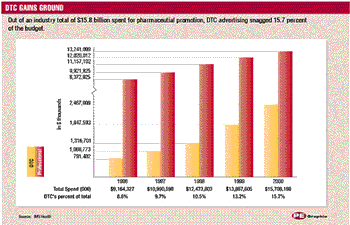
New York City—In response to the recent terrorist attack in its home city, Pfizer pledged nearly $10 million in aid.

New York City—In response to the recent terrorist attack in its home city, Pfizer pledged nearly $10 million in aid.

PMs must be ready to speak to the media at a moment’s notice—and have something to say.

London-European cancer patients are losing out because current processes for reviewing treatments are "dire," says the Cancer Research Campaign.

Mumbai, India—The controversy over pharma companies’ incentives to pharmacists in India highlights just how competitive the Indian pharma industry has become.

Not only did Shakespeare know a great deal about human nature, he knew something about brand equity: a name has value. Four hundred years later, marketers grapple to understand the association between brands and profitability.

Menlo Park, California-Premiums for employer-sponsored health insurance jumped 11 percent from spring 2000 to spring 2001-the biggest increase since 1992-and payers blame that huge spike on pharmaceutical expenditures.

"My father had some great sayings, and one of them was: 'Never do a deal that's not a good deal for the other guy.'" So remembers Donal Geaney, chairman and CEO of Ireland-based Elan. Geaney's new American colleague Daniel Welch, president of Elan Pharmaceuticals, smiles in agreement from the other side of the table.

I heard the first bird of the morning whistling to his lover. Their small wings owned the sky again while the people fled for cover.

Demands on physicians aren't just coming from reps.

A new report from the Centers for Disease Control and Prevention examines women's use of ambulatory medical care in 1997 and 1998, and finds that their care differs from men in many significant ways. Even excluding pregnancy-related visits, women were 33% more likely than men to visit a doctor, although this difference decreased with age. The rate of doctor visits for such reasons as annual examinations and preventive services was 100% higher for women than for men, and medication patterns differed significantly. Women were not only more likely to receive hormones, but also dramatically more likely to have an antidepressant prescribed.

The Washington-based Pharmaceutical Research and Manufacturers of America has filed a lawsuit in federal court challenging a new Florida law that seeks to offset a $214 million reduction in the state's Medicaid prescription drug budget by creating a new state Medicaid formulary.

Ah … the infamous work contact! As a pharmaceutical representative, and then as a district sales manager in the late '80s, I became intimately familiar with the practice of riding with your manager from both the passenger's and the driver's sides of the car.

Nurses can be powerful advocates.

A national survey of employers, released jointly by the Menlo Park, CA-based Kaiser Family Foundation and the Washington-based Health Research and Educational Trust, found that smaller employers (three to 199 employees) are significantly more likely than larger employers (200 or more employees) to support a person's right to sue a health plan, and are somewhat more likely to support the right to appeal a health plan's decision to an independent reviewer. Two-thirds (67%) of smaller employers express support for the right to sue a health plan, compared with 28% of larger employers. Eighty-six percent of smaller employers and 74% of larger employers support independent review. However, the survey found that support for both the right to sue and independent review decreases if employers are told that the cost of health insurance might increase as a result.

As policy makers struggle to devise a pharmacy benefit for Medicare patients, pressure mounts to impose spending limits on medications. In turn, consumer activists are challenging industry’s longtime claim that price controls will reduce investment in R&D for life-saving therapies.

For the past 20 years, the blockbuster model has dominated the pharmaceutical industry. It has generated tremendous value for companies and shareholders and will likely continue to do so well into the future. That business design matched Big Pharma's expansive product development and marketing investments with the ample supply of opportunities for benefiting large patient populations and allowed an unusually large number of players to succeed in the high-stakes game. Not all companies can continue to win that game, however, so new fields of competition will be needed.

Berlin-The German healthcare system is ailing, and politicians are too timid and inefficient to do anything about it, according to the Verband Forschender Arzneimittelhersteller (VFA), Germany’s pharmaceutical industry trade association.

European Union-Both prescription and over-the-counter (OTC) industry sectors have welcomed the long-awaited proposals to overhaul EU pharma legislation.

If only two words could be used to describe Big Pharma's promotional spend trends during the past 12 months, they would be "it depends." Budgets are simply tools and the industry uses them as such: to determine just the right spend, on a certain type of product, during a particular phase of its life cycle.

The unprecedented proliferation of new digital and traditional media vehicles is surpassed only by the continued growth of pharma marketing budgets and promotional spending. The combination of the two has generated an industry stir-among product managers, their agency partners, and publishers-about what constitutes the optimal media mix for today's pharma brands.

California and New York may be the nation's most populous states, but they and other big states, like Florida, New Jersey, Minnesota and Massachusetts, placed at or near the bottom in per capita prescription drug use, according to St. Louis-based pharmacy benefit manager Express Scripts. The company measured per capita prescription drug use, across the nation, using a random sample of commercially insured members (age 18 to 64) of its pharmacy benefit plans.

The small incremental improvements to existing drugs that make up the majority of new drug approvals by the FDA each year provide important health benefits to patients.

Health and Human Services Secretary Tommy G. Thompson has announced a department-wide initiative to reduce regulatory burdens in healthcare and respond faster to the concerns of healthcare providers, state and local governments, and individual Americans who are affected by HHS rules.

More and more, physician meetings and events are becoming an integral part of pharmaceutical promotion, according to the Physician Meeting & Event Audit by Newtown, PA-based Scott-Levin.

Many of the communication and relationship-building skills that made Jan Hearn a great sales rep for nine years now make her a great corporate account manager. Promoted three years ago by Thousand Oaks, CA-based Amgen Inc., Hearn now works with corporate pharmacy staff, medical directors, CEOs, CFOs and COOs at five major integrated healthcare systems in three states to gain access and coverage for Amgen products. Although this new role required Hearn to undergo extensive training and master new skills, many challenges of relationship-building in the corporate environment aren't so different from those she faced as a rep.

According to Newtown, PA-based Scott-Levin, the movement toward larger sales forces that began in 1995 continues unabated despite consolidation within the pharmaceutical industry.

Scientists have developed a new tool that may help physicians predict, during the first several hours a stroke patient is in the hospital, the degree of recovery the patient will eventually experience. The tool uses three factors for the accurate prediction of stroke outcome: measurement of brain injury using magnetic resonance imaging, the patient's score on the National Institutes of Health Stroke Scale, and the time in hours from the onset of symptoms until the MRI brain scan is performed.

In 2000, the number of independent pharmacies grew by more than 200, according to the National Community Pharmacists Association, Alexandria, VA. Based on NCPA's definition of an independent pharmacy - single-store independent pharmacies, independent chains, pharmacy franchises and pharmacist-owned supermarket pharmacies - independent pharmacies now number 24,841, or 45% of the nation's total market of 55,011 pharmacies.

Challenging one of medicine's long-standing beliefs, a team of scientists funded by the National Heart, Lung, and Blood Institute and the National Institute on Aging has found the strongest evidence to date that human heart muscle cells regenerate after a heart attack. In a paper published in the New England Journal of Medicine (vol. 344, no. 23), scientists from New York Medical College in Valhalla, NY report their success in finding large-scale replication of heart muscle cells in two regions of the heart, and in identifying several other key indicators of cell regeneration.